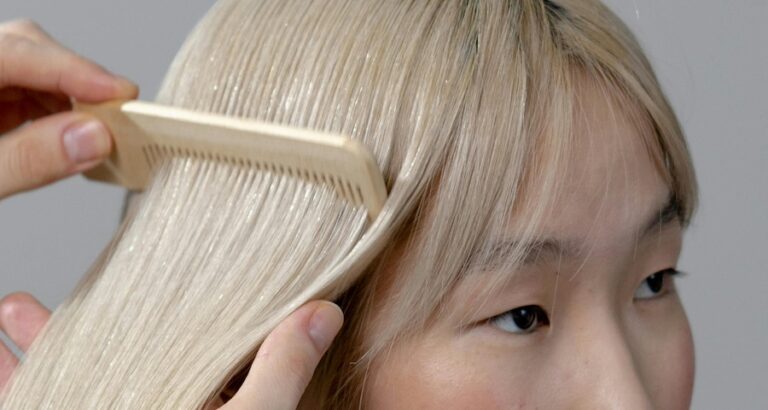“Slow and steady wins the (blonde) race.”
Most people I know have tried or at least thought about going blonde at some point in their lives. Whether it’s just a few highlights, half a head of foil, or (for the more daring) a full scalp bleach, it’s something many people have tried.
Depending on your hair type, this may have been a smooth transition and your hair remained mostly intact. In my case, trying to lighten my hair required multiple salon appointments lasting over five hours and multiple no-rinse treatments to avoid breaking the ends. Going blonde was a decision and I loved it, but it required constant attention and maintenance.
Want to take a peek at other creators’ beauty regimens? Head here.
On the other hand, my mother’s blonde bob is always a source of envy. Despite being a brunette, her hair can easily be lightened and extended with toning shampoo and conditioner. I follow in my father’s footsteps and inherited his family’s thick, thick Fijian hair.
Successful blonde hair depends on so many factors, so it’s best to seek advice from a professional. Stylist and owner of Rumbie and Co salon Rumbie Mutsiwa turned hairdresser after noticing a lack of salons that catered to textured Afro hair. As a stylist specializing in dark and curly hair types, she has steadily built a reputation in the industry, working with major clients such as Shark Beauty and styling hair at Australian Fashion Week . She also knows a thing or two about going blonde.
What happens when you bleach your hair?
Going blonde is more than just bleaching your hair, but it’s an important first step. Basically, hair bleach removes the color from your hair, so you can successfully use dye over it. Although this is a quick and easy way to achieve the desired shade, there are other factors to consider.
“Bleaching removes natural pigment, weakens hair and causes dryness,” Lambie says. The bleaching process reduces your hair’s moisture levels, changes its elasticity, and makes it more prone to split ends and breakage.
To keep your hair healthy, Lambie suggests using a moisturizing leave-in conditioner and enjoying a weekly ultra-hydrating hair mask or protein treatment.
Are certain hair types suitable for going blonde?
The result of bleaching your hair is determined by how dark your hair is initially. The longer you leave the bleach on, the more pigment will dissolve and the color will become lighter. Therefore, if your hair is of a blonde tone, the process will be faster than if your hair is naturally dark, and you may need a few additional rounds.
“Blonde is a fun and universal shade; it looks great on any hair type,” Lambie says. “But if your hair is brittle or thin, it will need some extra TLC.”
No matter what your hair type, Lambie suggests consulting a professional to transform your hair and find the right shade for you (this is an important step). Photos of things you like can be helpful for inspiration, but they’re just that: inspiration. Skin tone, eye color, and hair texture all need to be considered.
How to safely bleach your hair: advice for those who want to go from brunette to blonde hair
“Slow and steady wins the (blonde) race,” Lambie says. She recommends having a series of appointments, which can give your hair time to condition while reducing damage. “Skip the sudden harsh lighting session and make the transition go smoothly.”
Depending on how much weight you want to save, it’s worth considering your budget and time before making the switch. When I first lightened my hair, I had pictures and expectations of what I wanted my hair to look like. Luckily, my hairdresser was upfront about going blonde.
A half-foil head costs over $500. My hair was naturally dark and I had to sit in a salon chair for hours at a time. And it didn’t end there. Most hairdressers tend to recommend 6-8 week appointments to maintain color. I’ve loved the results every time, but it’s not a cheap effort.
Keeping your hair healthy throughout this process is also an important consideration. Lambie emphasizes that deep conditioning is paramount, as is using hair-friendly heat styling tools. “I think the Shark SpeedStyle tool is great for keeping hair happy and healthy after bleaching and minimizing heat damage,” Lambie adds.
common mistakes
Lambie says one of the biggest mistakes she sees is when people impulsively dye their hair blonde instead of styling it. It’s important to make sure your hair is healthy and strong so it can withstand the (often harsh) changes.
It is also important to work with experts. “The classic DIY bleach job is appealing, but it’s also very dangerous,” Lambie says. There are risks such as uneven color, scalp inflammation, and in the worst case, hair breakage. “Leave the weight reduction to the professionals.”
Even with professional techniques, bleached hair is often susceptible to damage, especially from heat styling. Lambie emphasized the importance of adding a heat protectant to your hair routine, adding, “Your hair will thank you!”
What to avoid
Freshly bleached hair is delicate and needs some love. “Avoid high temperatures, tight hairstyles, and other chemical treatments for at least two weeks,” Lambie advises.
“Keep your styling tools on a cool setting and avoid tugging or brushing. Relax, take it easy, and enjoy being blonde!”
If you want to know more about how to go blonde, try this.

